Authors
Aidan Foster-Carter

Aidan Foster-Carter is an honorary senior research fellow in sociology and modern Korea at Leeds. He is also a freelance analyst and consultant: covering the politics and economics of both South and North Korea for, amongst others, the Economist Intelligence Unit, Oxford Analytica, and BBC World Service. Between 1991 and 1997 he lectured on sociology at the universities of Hull, Dar es Salaam (Tanzania), and Leeds. A prolific writer on and frequent visitor to the Korean Peninsula, he has lectured on Korean and kindred topics to varied audiences in 20 countries on every continent. He studied Classics at Eton, Philosophy, Politics, and Economics at Balliol College Oxford, and Sociology at Hull.
Articles by Aidan Foster-Carter

North Korea - South Korea
September — December 2023Both Koreas Ditch Their Border Accord
The last third of 2023 was eventful in Korea, especially the two final months. Fall found South Koreans preoccupied with events elsewhere, and their implications for the peninsula. In September, Kim Jong Un’s Siberian summit with Vladimir Putin prompted worries as to how closer Pyongyang-Moscow military ties might affect the ROK. In October, Hamas’ shocking attack on Israel added a new layer of alarm, warranted or otherwise. President Yoon Suk Yeol was among those expressing fear that the DPRK might launch a similar surprise assault. He soon had less hypothetical concerns. In November, in response to Pyongyang’s successful launch (following two earlier failures) of a military reconnaissance satellite, Seoul partially suspended 2018’s inter-Korean military accord—whereupon the North predictably scrapped it entirely. Tensions grew as both sides rearmed at the ironically named Demilitarized Zone (DMZ), and talked tough — none tougher than Kim Jong Un, who spoke openly of occupying the South. As the year ended, Kim declared a major change in DPRK doctrine. Dropping its longstanding lip service to reunification, the North now regards the peninsular situation as “relations between two belligerent states.” The implications of this shift remain to be seen.
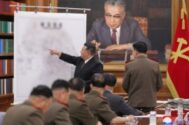
North Korea - South Korea
May — August 2023In Both Pyongyang and Seoul, an Ominous Hardening
In mid-2023, the (non-existent) relations between the two Koreas got even worse, if that were possible. Confronting enlarged US-ROK military exercises, and the first visit of a US nuclear-armed submarine to the peninsula since 1981, Pyongyang’s nuclear threats grew ever more frenzied. In Seoul, President Yoon Suk Yeol institutionalized his hard line by downsizing and repurposing the Ministry of Unification (MOU). Criticizing MOU for acting in the past as a support department for North Korea, Yoon evidently conceives its future role as being to hinder Kim Jong Un’s regime—publicizing its human rights abuses, for instance—rather than help. Much as the DPRK’s ever-expanding WMD threat requires robust deterrence, for Seoul to start emulating Pyongyang’s unalloyed hostility hardly seems conducive to peace. The period under review also saw two attempts by North Korea to put a spy satellite into orbit; both failed. By contrast, the North’s missile launches hardly ever go wrong these days. The large solid-fuel Hwasong-18 ICBM, with a 15,000-km (9,300-mile) range, which first flew in April, had a second successful test on July 12.
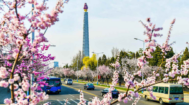
North Korea - South Korea
January — April 2023North Cranks up Nukes—and Slams Down the Phone
The first four months of 2023 brought no progress or respite in inter-Korean relations. Pyongyang sent no further drones into Southern airspace as it had in December, but continued to rattle Seoul with tests of advance weaponry and ever more lurid nuclear rhetoric. South Korea hardened its language and stance, with a restored emphasis on human rights in the North—now officially defined as an enemy once more. ROK President Yoon Suk Yeol also found enemies within: leftists who made contact with the DPRK in third countries were no longer ignored but prosecuted. More ominously, so were four top officials who served the previous president, Moon Jae-in, over how they handled two difficult inter-Korean incidents in 2019-20. Elsewhere, Seoul complained in vain about Pyongyang’s abuse of its assets in two defunct joint ventures: stealing some, destroying others. Soon after, the North stopped answering the phone. It is hard to see how North-South relations will improve, but all too easy to imagine them getting even worse.
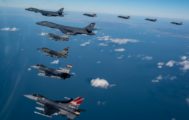
North Korea - South Korea
September — December 2022Drones in a Darkening Sky, Tactical Nuke Talk: Pyongyang’s Provocations Escalate
The main feature of inter-Korean relations in the last four months of 2022 was varied and ever-increasing provocations by Pyongyang. Besides multiple missiles, there were artillery volleys and an incursion by five drones. Kim Jong Un also ramped up his nuclear threats, in theory and practice. A revised law widened the scope of nuclear use, while a new stress on tactical weapons was matched by parading 30 new multiple launch rocket systems (MLRs) which could deliver these anywhere on the peninsula. The government of South Korean President Yoon Suk Yeol for his part reinstated officially calling North Korea an enemy, and revived concern with DPRK human rights. As the year turned, his government was mulling retaliation for the drone incursions; that could include scrapping a 2018 inter-Korean military accord, a dead letter now due to Pyongyang’s breaches. With tensions rising, the new year ahead may be an anxious one on the peninsula.
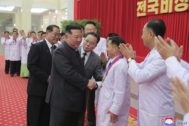
North Korea - South Korea
May — August 2022An Inauspicious Start
On May 10 Yoon Suk Yeol took office as ROK president, and rapidly lost popularity. While talking tough on North Korea, he also offered aid to fight COVID-19—but was ignored. His “audacious plan,” wholly unoriginal, to reward Pyongyang materially if it denuclearizes, had very little detail. For months the DPRK did not even mention Yoon. In late July Kim Jong Un sharply warned him against any pre-emptive strike. In August, his sister Kim Yo Jong put the boot in: ludicrously blaming materials sent by ROK activists for bringing COVID-19 into the DPRK, savaging Yoon’s proposal as insulting and unoriginal, and saying the North will never talk to him. At home, meanwhile, the new government chose to reopen two contentious inter-Korean episodes from the recent past, seemingly to punish its predecessor’s policies. It was hard to see how good could come of that, or to hold out hope for any thaw on the peninsula.

ROUNDTABLE
June 13, 2022Flashpoints in the Indo-Pacific Following the Russian invasion of Ukraine
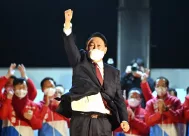
North Korea - South Korea
January — April 2022From Moon to Yoon: End of an Era
The first months of 2022 were also the last of Moon Jae-in’s presidency. Inter-Korean relations have been frozen for the past three years, and 2022 saw no change there. In April Moon exchanged letters with Kim Jong Un, whose warm tenor belied the reality on the ground. The North was already testing more and better missiles faster than ever, and tearing down ROK-built facilities at the shuttered Mount Kumgang resort. Days after his billets-doux with Moon, speaking at a military parade, Kim threatened ominously to widen the contexts in which his ever-improving nuclear arsenal might be used. All these challenges confront a new leader in Seoul. Unlike Moon, the conservative Yoon Suk-yeol is new to politics, but not minded to indulge Kim. His ministerial and other appointees, who have now taken over, are already striking a firmer note—while also stressing their pragmatism and openness to dialogue. Very recently a fresh threat—or perhaps an opportunity—has arisen, with the North finally admitting an outbreak of COVID-19. Yoon promptly offered vaccine aid. It remains to be seen if Kim will accept this, how he will handle the omicron outbreak, whether he will proceed with a widely expected nuclear test, and how Yoon and Biden will handle an ever more complex crisis.
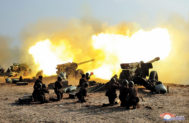
North Korea - South Korea
September — December 2021Waning Moon, Supersonic Kim
Korea’s leaders offered contrasting New Year addresses. While Moon Jae-in pledged to keep pursuing peace until he leaves the Blue House in May, Kim Jong Un said nothing about South Korea or the US. He sent his message soon after, however testing two hypersonic missiles. Moon kept pushing for a peace declaration, despite Washington being lukewarm and Kim Jong Un’s sister Yo Jong saying explicitly that the time is not ripe. Evaluating Moon’s nordpolitik more widely as his term winds down, his refusal to rethink policy after three years of Kim shunning him is puzzling. His successor, whoever it be, will pay Kim less heed. Voters will decide on March 9; the frontrunner is the liberal continuity candidate, Lee Jae-myung. Cocking a snook at both governments, a young gymnast who in late 2020 scaled and jumped border fences to escape from North Korea changed his mind and went back—the same way.
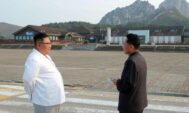
North Korea - South Korea
May — August 2021Summer False Dawn: On/Off Communications
Summer 2021 saw a false dawn on the Korean Peninsula, hardly the first, but surely one of the shortest. On July 27 both North and South announced the reconnection of inter-Korean hotlines, severed for over a year. In Seoul, hopes were high—aren’t they always?—that this signaled a fresh willingness by Pyongyang to engage, not only with South Korea but also the US. Yet this “breakthrough” lasted barely a fortnight. When the US and ROK began their regular August military exercises—albeit scaled back and wholly computer-based—North Korea snarled and stopped answering the phone. Inter-Korean relations remain frozen, as they have been ever since early 2019. With Moon Jae-in’s presidency due to end next May, any real melting of the ice looks increasingly like a challenge for his successor.
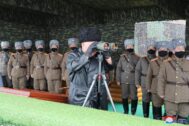
North Korea - South Korea
January — April 2021The Sound of One Hand Giving
As in 2019-20, inter-Korean ties remained frozen, other than a rare lawsuit. Revelations that in 2018 Moon Jae-in’s government had pondered building the North a nuclear power plant caused a brief furor. Seoul’s propaganda balloon ban backfired, prompting widespread criticism—but no thanks from Pyongyang, which was also unimpressed by scaled-down US-ROK war games. North Korea tested its first ballistic missile in nearly a year, amid concerns of a new arms race; some analysts deemed the South culpable, too. Kim Jong Un’s sister Kim Yo Jong fired four verbal volleys, mostly insults. Another undetected defector highlighted failings in ROK border security. MOU Lee In-young was ubiquitous and loquacious, but scattergun in the causes he championed. Moon’s government remained reticent, or worse, regarding DPRK human rights abuses. With just a year left in office, and notwithstanding rare criticism of the North by ministers, Moon was expected to double down on engagement despite Pyongyang’s lack of reciprocity.